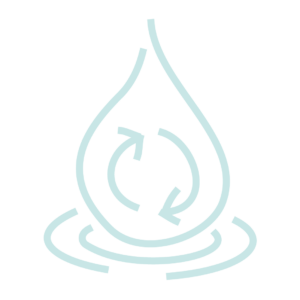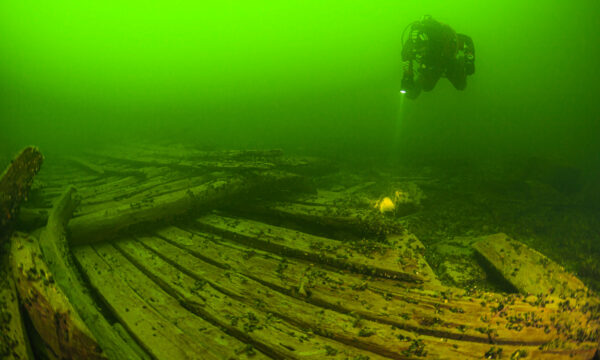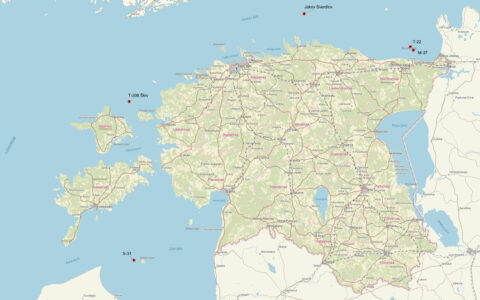02.02.2023 | Case | Baltic Sea | Shipping | Estonia
The Baltic Sea floor in Estonia contains more than 400 shipwrecks, which may pose a threat to the health of the Baltic Sea as they deteriorate. The Estonian Police and Border Guard is surveying the potential environmental damage caused by shipwrecks to the local marine environment with a grant from the Baltic Sea Action Plan Fund.
The Baltic Sea was the site of numerous battles during the first and second World Wars. Many ships were sunk at sea along with ammunition, unknown amounts of heavy fuel oil and other hazardous substances. According to the Estonian Wreck Register (2016), there are about 400 wrecks in Estonian waters, 28 of which pose a threat to the environment and could contain fuel, ghost nets, explosives and other dangerous substances.
In 2019, the Estonian Ministry of Environment conducted a risk assessment of some of the wrecks based on the compiled data. The report highlighted the potential danger of the wrecks and the need to act to prevent further natural disasters. In 2022, the Estonian Police and Border Guard Board received a grant from the Baltic Sea Action Plan Fund (BSAP Fund) for preventive measures to ensure marine environmental safety.
“Information about the wrecks is mainly based on archival sources. Therefore, our knowledge of the wrecks on the seabed is very limited, and conducting underwater surveys and detecting potential threats is very important”
Mati Kose, biologist, Estonian Navy.
Shipwrecks: a source of marine pollution
Marine pollution and hazardous substances have long-term consequences for marine biodiversity. These substances can accumulate in the marine food chain, become toxic to marine organisms and ultimately to humans. Pollution can cause declines in the number of species associated with aquatic environments, damage coastal areas and change the functionality of ecosystems.
Shipwrecks can present a unique threat, depending on the type of vessel, cause of sinking, hull conditions, estimated amount of fuel on board and environmental preconditions. The oil types in wrecks vary from heavy and persistent oils, such as bunker oils, which are not biodegradable, to lighter oils like diesel. Furthermore, other physical, biological and chemical factors can contribute to the weathering of oils, altering their composition in the sea and increasing the risk of natural marine disasters.
In Estonia, most coastal areas are in shallow waters, which increases the risk of pollution to marine ecosystems. Thus, immediate actions were needed to prevent environmental issues in the area.

Pollution consequences for marine biodiversity:
- introduction to marine food chain
- toxic to marine organisms and humans
- decline of aquatic life
- damage on coastal areas and ecosystems functionality
Solution: survey of wrecks and removal of hazardous substances
The Estonian Police and Border Guard Board are carrying out a study of up to ten wrecks that present a high risk of environmental pollution. The ongoing project, scheduled to last until 2024, will provide an overview of the shipwrecks in the Estonian Baltic Sea waters, including an action plan for the most dangerous wrecks that require sources of pollution to be quickly removed.


“Information about the wrecks is mainly based on archival sources. Therefore, our knowledge of the wrecks on the seabed is very limited, and conducting underwater surveys and detecting potential threats is very important,” said Mati Kose, biologist, Estonian Navy.
Actions include:
- technical feasibility studies taking into account a wreck’s age and location
- assessment of the estimated quantity of oil on board and its potential leakage and discharge from the vessel
- suggestions for suitable offloading methods
- field work based on previous studies, 3D modelling and historical sources.
Underwater studies will take place in 2023 and will also detect the presence of ghost nets, explosives and any other environmentally hazardous cargo that is visible on the wreck.
The project is being conducted in collaboration with the Estonian Ministry of Interior, Estonian Ministry of Environment, Estonian Navy and the Environmental Investment Centre (EIC). For more information about the Estonian Police and Border Guard Board, visit: www.politsei.ee/en
About the BSAP Fund
The Baltic Sea Action Plan Fund (BSAP Fund) was set up in 2010 to help speed up the implementation of the Baltic Sea Action Plan (BASP), adopted by the HELCOM countries in 2007, which includes 200 concrete actions aiming for a healthier Baltic Sea. The key purpose of the BSAP Fund is to facilitate and speed up the preparation of bankable projects by both public and private entities. As of the end of 2022, the BSAP Fund has funded 47 finalised demonstrable projects ranging from nutrient recycling and manure management to small-scale sanitation plants and harbour facilities for wastewater management. The fund is co-managed by the Nordic Investment Bank (NIB) and Nefco with contributions from Sweden and Finland.
A new Call for Proposals will remain open until 6 February 2023. For more information, please visit: www.nefco.int/BSAP
Photo credits: Environmental Investment Centre (EIC) and Erik Saanila
Case summary

